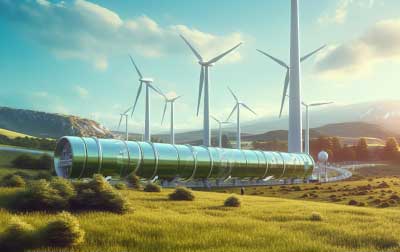The hydrogen conundrum: Unraveling the pros and cons of blue and green hydrogen production

However, the widespread adoption of hydrogen faces a conundrum: the challenges of producing it efficiently and sustainably. As we explore the two main methods of hydrogen production—blue and green hydrogen—and dive into the pros and cons along with what needs to be improved upon moving forward, we can begin to understand how to overcome technological barriers to make hydrogen energy a viable reality.
Energy transformation and the hydrogen conundrum Looking at investments, plans, and projects for the next twelve months, much of the attention and focus within the oil and gas industry lies within the energy transformation—specifically green electricity and hydrogen.
We can all agree that burning fossil fuels is hurting us; a decarbonization strategy is desperately needed and is well underway.
As a result, we’re thinking and creating innovatively. Traditional, fixed energy sources—solar, wind, oil, gas, and coal—are being converted to nuclear and geothermal, and hydrogen is the next big thing. By putting hydrogen front and center however, we’re in fact creating a conflict.
Hydrogen itself isn’t a source of energy—it’s a carrier, meant to be used directly by the consumer. But when we’re creating hydrogen as an energy source, it must first be converted to electrons, which are also energy carriers, and these electrons must be converted to hydrogen. This creates two carriers in the generation-to-consumer process.
With this in mind, generation-to-consumer becomes a four-step process:
- Generating power
- Converting the power to electrons
- Converting the electrons to hydrogen, and then
- Transporting the hydrogen over long distances to the user.
To oversimplify this, the process is equivalent to ordering a package, having it shipped by Purolator, who then ships to UPS, who then ships to the consumer.
There is no need for two carriers, and the inefficiencies of this power conversion process give us lots to consider and improve upon.
Blue hydrogen: A pragmatic path forward?
Blue hydrogen relies on natural gas—a fossil fuel—as its primary feedstock. The process begins with steam methane reforming, where natural gas reacts with steam to produce hydrogen and carbon dioxide. The carbon dioxide is then captured and stored, preventing it from entering the atmosphere. This carbon capture and storage (CCS) is the defining characteristic of blue hydrogen and is seen as a bridge solution to decarbonizing industries that rely on hydrogen.
While blue hydrogen significantly reduces carbon emissions and can be stored for long periods of time—allowing it to be a reliable and stable energy source, especially for intermittent renewable energy—the process of capturing and storing the carbon dioxide requires additional energy. It also relies on natural gas, perpetuating a dependence on fossil fuels and postponing the goals of a fully renewable energy future.
Green hydrogen: A renewable ideal?
Green hydrogen, on the other hand, is produced using electrolysis, which involves passing an electric current through water to separate into hydrogen and oxygen. The electricity required for electrolysis can come from renewable sources, making green hydrogen a truly renewable and sustainable energy carrier.
On the other hand, the high cost of green hydrogen production can be a barrier, along with scaling challenges and the challenge of optimizing electrolyzer technologies. Many regions also face barriers when it comes to accessing clean water for electrolysis, begging the question of whether the energy spent should be used elsewhere.
So, what does this mean for hydrogen? To make hydrogen energy more efficient and overcome technological barriers, significant advancements are needed in several key areas:
- Electrolyzers. Research and development in electrolyzer technologies are crucial to improve efficiency, durability, and improve costs. New materials and advanced catalysts can enhance the performance of electrolysis, making green hydrogen more economically viable.
- Thermodynamics and efficiency. Understanding the thermodynamics of hydrogen production process is vital for optimizing energy usage and minimizing loss.
- Renewable energy infrastructure. Governments and industries must continue to invest in renewable energy infrastructure to ensure a stable and ample supply.
- Energy storage and transportation. Developing efficient methods of storage and transportation for hydrogen is critical to support its successful integration.
The hydrogen conundrum presents a complex yet promising challenge for a sustainable future. With both blue and green hydrogen having their merits and drawbacks, one must separate hydrogen from its colors, and instead focus on its inclusive value based on the overall carbon footprint. By addressing the challenges and looking toward implementing hydrogen with existing infrastructure, we can separate hydrogen from its color categorization and look to it as a sustainable way forward.
We’re optimistic about the future. About reducing carbon emissions from oil and gas. About maximizing green technologies and providing accessible and sustainable energy for all.
Learn more about how we are responding to the energy transformation here.
Related content:
Navigating the path to decarbonization: strategies for oil refineries
Triaging our efforts to achieve global CO2 reduction targets
People - the hidden barrier to achieving net zero emissions
Tackling the energy trilemma—globally

Sanjiv Save
, PhD
Managing Director, Oil & Gas
As Hatch’s managing director of oil and gas, Sanjiv holds a solid background from the ground-up within the industry including technical qualifications, organizational and management skills, excellent problem-solving skills, and the ability to transcend cultural barriers to effectively coordinate projects. He brings over thirty years of professional experience within owner and consulting companies in project and business management for multidisciplinary EPC projects, mainly in the hydrocarbon and energy sectors. This includes the functions of project contract administration, costs control, cash flows, planning and scheduling, besides the design and development of project controls systems. His strong research and development background has led to the publication of several high-quality papers, chapters, and patents. Specific areas of technical expertise include heavy oil upgrading and green fuels, ammonia, hydrogen generation storage and transport, carbon capture and sequestration.